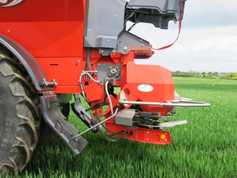Leanne Roche from Teagasc Johnstown Castle presented her research findings at the soil fertility conference, which showed spring barley, fertilised with protected urea, had similar yields as that fertilised with CAN.
The advantages of using urea over more traditional CAN is that urea is more stable in the soil, with lower greenhouse gas emissions and risk of nitrate leaching.
However, where ordinary urea is used, variable ammonia nitrogen losses occur depending on weather conditions but when the urea is protected, ammonia losses are reduced. In her experiment, the urea was coated with 660ppm of NBPT.
NBPT is available in commercial products such as KAN, AGRHO N, Protect B and Eco-COAT.
Leanne’s experiment was conducted on a site in Wexford between 2013 and 2015. Grain yield and nitrogen uptake were measured over three years, while gaseous emissions and nitrate leaching were measured over two years.
There were four treatments; the control was unfertilised, while the other three plots were fertilised with 150kg/ha of nitrogen spread over two applications. The fertiliser treatments were CAN, urea and protected urea.
Findings
Grain yields were similar regardless of the nitrogen products used. The CAN treatment yielded 8.3t/ha, the urea treatment yielded 8.4t/ha, the protected urea treatment yielded 8.6t/ha and the control treatment yielded 3.1t/ha. Leanne cautioned that while the crop yields in her trial were similar with urea as CAN and protected urea, some other trials have shown more variable yields with urea.
In terms of nitrogen uptake, she found that it was about 13kg/ha higher with protected urea compared with CAN.
When it came to gaseous emissions of nitrous oxide, she found no difference between the treatments. As expected, ammonia losses were higher when urea was used but there was no difference with CAN when protected urea was used.
“Overall, if using protected urea, you can be confident of producing at least the same spring barley yields as could be achieved using CAN but with potential cost and environmental benefits,” Leanne said.
Read more
Teagasc launches online soil fertility mapping service
Leanne Roche from Teagasc Johnstown Castle presented her research findings at the soil fertility conference, which showed spring barley, fertilised with protected urea, had similar yields as that fertilised with CAN.
The advantages of using urea over more traditional CAN is that urea is more stable in the soil, with lower greenhouse gas emissions and risk of nitrate leaching.
However, where ordinary urea is used, variable ammonia nitrogen losses occur depending on weather conditions but when the urea is protected, ammonia losses are reduced. In her experiment, the urea was coated with 660ppm of NBPT.
NBPT is available in commercial products such as KAN, AGRHO N, Protect B and Eco-COAT.
Leanne’s experiment was conducted on a site in Wexford between 2013 and 2015. Grain yield and nitrogen uptake were measured over three years, while gaseous emissions and nitrate leaching were measured over two years.
There were four treatments; the control was unfertilised, while the other three plots were fertilised with 150kg/ha of nitrogen spread over two applications. The fertiliser treatments were CAN, urea and protected urea.
Findings
Grain yields were similar regardless of the nitrogen products used. The CAN treatment yielded 8.3t/ha, the urea treatment yielded 8.4t/ha, the protected urea treatment yielded 8.6t/ha and the control treatment yielded 3.1t/ha. Leanne cautioned that while the crop yields in her trial were similar with urea as CAN and protected urea, some other trials have shown more variable yields with urea.
In terms of nitrogen uptake, she found that it was about 13kg/ha higher with protected urea compared with CAN.
When it came to gaseous emissions of nitrous oxide, she found no difference between the treatments. As expected, ammonia losses were higher when urea was used but there was no difference with CAN when protected urea was used.
“Overall, if using protected urea, you can be confident of producing at least the same spring barley yields as could be achieved using CAN but with potential cost and environmental benefits,” Leanne said.
Read more
Teagasc launches online soil fertility mapping service






 This is a subscriber-only article
This is a subscriber-only article










SHARING OPTIONS: